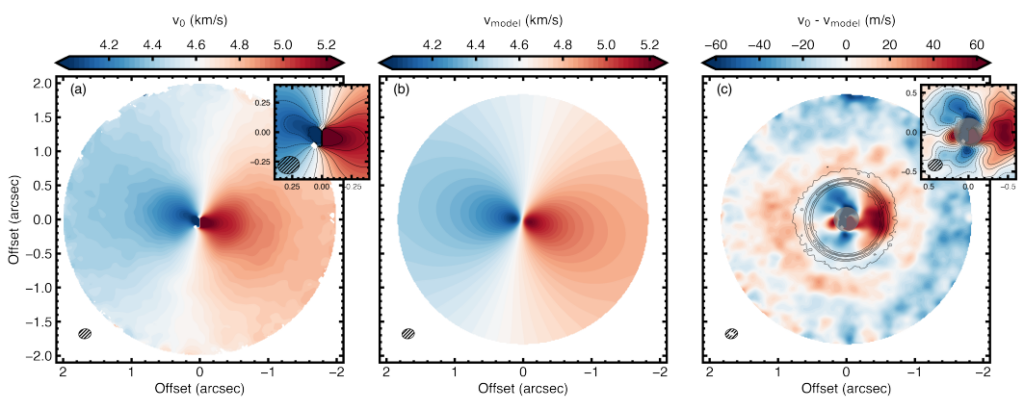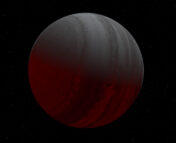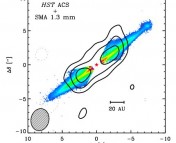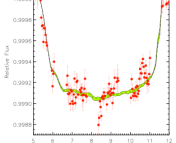Title: A kinematically detected planet candidate in a transition disk
Authors: J. Stadler et al.
First Author’s Institution: Laboratoire Lagrange, Université Côte d’Azur, CNRS, Observatoire de la Côte d’Azur, France
Status: Published in A&A Letters [open access]
When we peer into the night sky, no matter which direction we look, thousands of stars fill the universe all around us. Those little pinpricks of light have captured our attention and been the subject of study and philosophy for millennia. Today, we not only understand them much better for what they are, but also for what they host: while we have confirmed the existence of “only” over 5000 planets in stellar systems other than our own, some scientists believe that nearly every star in the universe could have at least one planet.
As it turns out, planetary formation is a common and effective process. As young stars are born from a collapsing cloud of gas and dust, the remaining material coalesces around the newborn star, forming a protoplanetary disk. Through gravity, small grains of material in the disk interact with one another, crashing together to form larger and larger masses – becoming planetesimals, the seeds of future planets.
Protoplanetary disks have been observed around many young star systems through telescopes and instruments such as ALMA, the Atacama Large Millimeter/submillimeter Array of radio telescopes in northern Chile. This is because the light from interstellar gas and dust is emitted in the radio, at millimeter and submillimeter wavelengths, far different from hotter stars and high-energy sources. Thus, they shine brightly when observed at these wavelengths. With the most powerful, high-resolution imaging facilities available, scientists have been able to observe not only the existence of the disks themselves, but also resolve substructures and kinematics within them.
The authors of today’s Letter report their results of observations and analysis of RXJ1604.3-2130 A (hereafter J1604), a particularly bright protoplanetary disk just under 145 parsecs from Earth. J1604 is what is known as a transition disk: a protoplanetary disk that is in the process of dispersing or accreting away (as all disks eventually do), characterized by a cavity in the innermost region of the disk where the hottest, closest material to the star has already disappeared. These gaps could be due to evaporation of the material, dispersion from stellar winds… or they could be signs of the existence of planets that depleted or swept up the material as they formed. As such, transition disks like J1604 are good candidates for the discovery of young extrasolar planets, and for observing and understanding their birth and growth.
Shine Bright like Carbon Monoxide
The authors combined 5 new sets of ALMA observations of J1604 with archival data from 2016 for their data analysis. The data contained observations throughout the spectral continuum, but they also singled out the 12CO J=2-1 emission line; this particular signal of carbon monoxide emission is one of the brightest millimeter-wave spectral lines emitted by interstellar gas and dust, and so is often used to observe and characterize planetary disks.
With the data in hand, the authors used various code packages to model the kinematics of the disk, and the intensity of specific emission lines. The results of the observations are shown in Figure 1, and the best model results for the velocity of the disk material are shown later on in Figure 2. Since J1604 is nearly face-on from our point of view on Earth – as if we were looking down onto the disk from above – a large extent of the disk can be seen in the observations.

Both the continuum and 12CO observations show a clear bright, hot disk at a certain radius around the star; inside that radius, however, there is a very clear dark and cold cavity between the disk and the star, typical of a transition disk. An interesting note is that the bright disk radii do not perfectly match up between the continuum and the 12CO maps: the 12CO line emission extends further inwards than the continuum emission, and furthermore, appears asymmetrical with respect to the position of the star. Finally, both continuum and 12CO observations show significant intensity variations within the dust cavity, with east-west regions of the cavity being fainter than north-south regions. These fainter regions are also broadly aligned with shadows reported in scattered light observations of J1604.

The velocity maps also reveal interesting features in the disk. For example, the velocity data in Fig 2a) show a bending or ‘warp’ in the central velocities of the disk, possibly due to a misaligned inner disk, though higher resolution observations are required to assess that properly. Furthermore, when the disk velocity model in Fig 2b) is subtracted from the data in 2a), very prominent local velocity features are observed in Fig 2c). In particular, after further analysis of the residuals, the authors strongly confirm the existence of two non-Keplerian velocity features: (1) one prominent ~60 m/s feature near the inner edge of the dust ring, and (2) an extensive spiral-like feature outside of the ring, which was found to be a coherent structure after further analysis.
A Planet is Born?
While the inner feature (1) initially appears reminiscent of perturbations due simply to rotational velocities of material within the ring, the magnitude of the velocity of the feature is significantly too high to be due to this effect alone. Often, these perturbations can also be signs of disk-planet interactions: a massive planetary companion beginning to carve out a space in the disk. Comparing the velocity results with simulations and semi-analytical methods, if this effect is caused by a planet, the authors estimate its orbit to be ~41 AU from the star, with a mass within the range of 1.6-2.9 Jupiter masses.
In addition, the extended spiral feature (2) appears to be related to this significant velocity residual as well. Due to its shape and extent, the authors speculate the spiral is caused by resonances excited by the orbit of the massive planet candidate within the ring.
However the existence of such a planet at this distance from the star is not enough to explain several other features of the disk. Firstly, it would not be located close enough to the star to explain the gas cavity. Secondly, according to photometry of the disk taken in 2018, the accretion rate of material from the disk to the star is lower than would be expected. Finally, there is the misalignment or warping of the inner disk as seen in Fig 2a).
As a result of these features, the authors speculate that there could be a second, very massive companion to J1604 (possibly even a stellar companion!) within ~35 AU – if this supposed companion orbited J1604 at a very inclined angle (perhaps almost perpendicular) to the disk, it could explain the misalignment of the inner disk, as well as the previously reported shadows.
In conclusion, the authors of today’s Letter report the detection of coherent, localized, non-Keplerian features in ALMA observations of the transition disk around RXJ1604.3–2130 A, and after data analysis, interpret these features as signs of a planetary companion within the disk. However, since this planetary candidate cannot explain all of the intriguing properties of the disk, they hypothesize the existence of another massive companion on an inclined orbit closer to J1604. Further, higher-resolution observations of the inner disk would be required to shed light on this intriguing possibility.
Astrobite edited by Abby Lee
Featured image credit: ALMA (ESO/NAOJ/NRAO)




